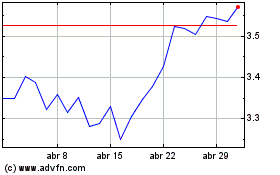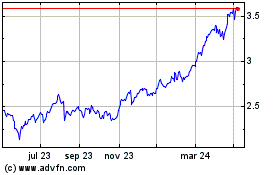By Patricia Kowsmann and Margot Patrick
European banks say they are doing just fine during the
coronavirus pandemic. But regulators and bank executives are
concerned about the elephant in the room: a wave of bad loans that
could overwhelm lenders when government rescue packages end.
The economies of Europe plunged this year, and fresh lockdowns
in many countries are weighing on nascent recoveries. Yet the
unprecedented levels of government and financial-sector support,
including repayment moratoriums sometimes covering a quarter of all
outstanding loans, have kept households and companies afloat. That
means banks haven't had to recognize those loans as potentially
soured.
Even bank CEOs are wondering what happens when the support
ends.
"What we have is a very strange crisis" in which economies are
falling sharply but defaults aren't rising mostly because of the
relief measures, Steven van Rijswijk, chief executive of ING Groep,
said last week. "When these measures stop, what then will the
picture be? We have limited visibility as of yet."
Regulators fear some European banks are too slow to react to
borrowers' potential troubles ahead. The European Central Bank said
bad loans in the eurozone could soar as high as EUR1.4 trillion,
equivalent to $1.7 trillion, if the economies fall even more than
expected, a scenario the central bank said is severe but plausible.
That amount would be more than during the aftermath of the
financial crisis.
The concern is that banks could run out of capital if they are
suddenly overwhelmed by defaults, needing state support or even
failing. What isn't clear right now is how quickly those defaults
could pile up, or if state programs might cushion banks' losses for
years to come.
Elke König, head of a European Union agency set up after
Europe's financial crisis to handle troubled banks, said lenders
need to act quickly to identify and deal with loans that are
unlikely to be repaid. "There is no magic wand to make potential
losses go away," Ms. König said.
European banks were already far behind U.S. rivals in recovering
from that last severe shock in 2008. Then, U.S. banks got help from
government programs and central banks to unload bad assets quickly,
while banks in Europe became ensnared by a sovereign-debt crisis
that curbed economic growth. Low interest rates, imposed to
stimulate spending, further hit banks' profits.
This time around, U.S. workers who lost their jobs got weekly
payments of $600 for several months, while others stayed at work
because of Paycheck Protection Program loans to small
businesses.
While many U.S. banks let borrowers skip some payments, overall
support has been less generous than in Europe.
In Italy -- where banks are still trying to deal with old
bad-debt portfolios -- over 25% of loans to businesses and 15% to
households, totaling around EUR300 billion, were put under payment
holidays, according to Marco Troiano, deputy head of the banks team
at the ratings company Scope Ratings. The country was for a long
time the epicenter of the virus outbreak in Europe and has been
hurt by a collapse in tourism.
In Portugal, where companies and the government are highly
indebted, loan moratoriums to businesses covered almost a third of
the total, according to the country's central bank. Over half of
the credit to companies in the hospitality and restaurant sectors
are under the program.
"Until the moratoriums are resolved, it will be challenging to
assess the real extent of losses," Mr. Troiano said.
Carlo Messina, chief executive of the Italian lender Intesa
Sanpaolo, sounded upbeat in recent comments, saying that despite
the pandemic his bank had the lowest-ever inflow of bad loans in
the first nine months of 2020.
In Spain and elsewhere, "customers' behavior has been better
than the guidance we gave in April and July," said Ana Botín,
executive chairman at Banco Santander SA, a major lender in Europe
and Latin America. Most borrowers restarted payments when
moratorium programs expired, she said, and the ratio of
nonperforming loans actually fell this year. Around EUR40 billion
in loans, or 4% of Santander's loan book, is still under
moratorium, including many Spanish mortgages.
According to an analysis by Spain's central bank, the heaviest
users of payment holidays are households that were already more
financially vulnerable. It estimates that more than EUR52 billion
of household and personal business loans in Spain, or about 8% of
those that qualify, is currently on hiatus.
Countries across Europe have also rolled out subsidies to
companies so they could keep idled workers, preventing unemployment
from shooting up. In contrast, the jobless rate had jumped in the
U.S.
Part of the reason for the rosy picture from banks comes down to
accounting rules. Banks can typically count a loan as performing
until there is actual deterioration, such as missed interest
payments or a company going bankrupt.
Andrea Enria, the head of the ECB's supervision arm, said some
banks are being optimists and waiting until there is concrete
evidence a customer is going bankrupt. He told European lawmakers
last month that banks shouldn't let loans "rot in their balance
sheets."
European banks are lending now, including more than EUR400
billion to businesses this year under government programs that
guarantee a chunk of the repayment to the banks. The programs are
giving companies much-needed cash to keep their businesses going,
but they can also keep nonviable companies alive.
Local cinemas, family-run restaurants and hair salons are among
the businesses receiving such loans, according to announcements by
banks, even though it is unclear when those sectors will fully
recover.
"At the moment the biggest bank is governments," said Matt Long,
head of capital markets for Europe at Accenture. "When that stops,
that's when we get to see the real ability of the borrowers to pay
back the loans and meet their borrowing commitments."
Write to Patricia Kowsmann at patricia.kowsmann@wsj.com and
Margot Patrick at margot.patrick@wsj.com
(END) Dow Jones Newswires
November 11, 2020 05:48 ET (10:48 GMT)
Copyright (c) 2020 Dow Jones & Company, Inc.
Intesa Sanpaolo (BIT:ISP)
Gráfica de Acción Histórica
De Mar 2024 a Abr 2024

Intesa Sanpaolo (BIT:ISP)
Gráfica de Acción Histórica
De Abr 2023 a Abr 2024
